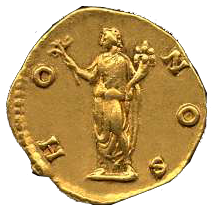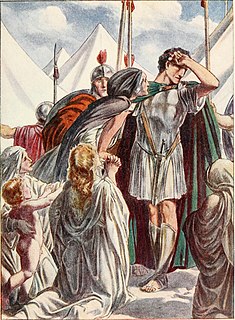Related Research Articles

Quintus Fabius Maximus Verrucosus, surnamed Cunctator, was a Roman statesman and general of the third century BC. He was consul five times and was appointed dictator in 221 and 217 BC. He was censor in 230 BC. His agnomen, Cunctator, usually translated as "the delayer", refers to the strategy that he employed against Hannibal's forces during the Second Punic War. Facing an outstanding commander with superior numbers, he pursued a then-novel strategy of targeting the enemy's supply lines, and accepting only smaller engagements on favourable ground, rather than risking his entire army on direct confrontation with Hannibal himself. As a result, he is regarded as the originator of many tactics used in guerrilla warfare.

Honos or Honor was the Roman god personifying honor. He was closely associated with Virtus, the goddess of manliness, or bravery, and the two are frequently depicted together. Honos is typically shown wearing a chaplet of bay leaves, while Virtus is identified by her helmet.

The princeps senatus was the first member by precedence of the Roman Senate. Although officially out of the cursus honorum and possessing no imperium, this office conferred prestige on the senator holding it.

The gens Fabia was one of the most ancient patrician families at ancient Rome. The gens played a prominent part in history soon after the establishment of the Republic, and three brothers were invested with seven successive consulships, from 485 to 479 BC, thereby cementing the high repute of the family. Overall, the Fabii received 45 consulships during the Republic. The house derived its greatest lustre from the patriotic courage and tragic fate of the 306 Fabii in the Battle of the Cremera, 477 BC. But the Fabii were not distinguished as warriors alone; several members of the gens were also important in the history of Roman literature and the arts.
Quintus Fabius Maximus Rullianus, son of Marcus Fabius Ambustus, of the patrician Fabii of ancient Rome, was five times consul and a hero of the Samnite Wars. He was brother to Marcus Fabius Ambustus.

The gens Mamilia was a plebeian family at ancient Rome during the period of the Republic. The gens was originally one of the most distinguished families of Tusculum, and indeed in the whole of Latium. It is first mentioned in the time of the Tarquins; and it was to a member of this family, Octavius Mamilius, that Lucius Tarquinius Superbus, the seventh and last King of Rome, betrothed his daughter. The gens obtained Roman citizenship in the 5th century BC, and some of its members must subsequently have settled at Rome, where Lucius Mamilius Vitulus became the first of the family to hold the consulship in 265 BC, the year before the First Punic War.

A dictator was a magistrate of the Roman Republic, entrusted with the full authority of the state to deal with a military emergency or to undertake a specific duty. All other magistrates were subordinate to his imperium, and the right of the plebeian tribunes to veto his actions or of the people to appeal from them was extremely limited. In order to prevent the dictatorship from threatening the state itself, severe limitations were placed upon its powers, as a dictator could only act within his intended sphere of authority, and was obliged to resign his office once his appointed task had been accomplished, or at the expiration of six months. Dictators were frequently appointed from the earliest period of the Republic down to the Second Punic War, but the magistracy then went into abeyance for over a century, until it was revived in a significantly modified form, first by Sulla between 82 and 79 BC, and then by Julius Caesar between 49 and 44 BC. The office was formally abolished after the death of Caesar, and not revived under the Empire.
Quintus Fabius Maximus may refer to:

The gens Licinia was a celebrated plebeian family at ancient Rome, which appears from the earliest days of the Republic until imperial times, and which eventually obtained the imperial dignity. The first of the gens to obtain the consulship was Gaius Licinius Calvus Stolo, who, as tribune of the plebs from 376 to 367 BC, prevented the election of any of the annual magistrates, until the patricians acquiesced to the passage of the lex Licinia Sextia, or Licinian Rogations. This law, named for Licinius and his colleague, Lucius Sextius, opened the consulship for the first time to the plebeians. Licinius himself was subsequently elected consul in 364 and 361 BC, and from this time, the Licinii became one of the most illustrious gentes in the Republic.
Titus Manlius Torquatus was a politician of the Roman Republic. He had a long and distinguished career, being consul in 235 BC and 224 BC, censor in 231 BC, and dictator in 208 BC. He was an ally of Fabius Maximus "Cunctator".
Quintus Fabius Q. f. M. n. Maximus Gurges, the son of Quintus Fabius Maximus Rullianus, was consul in 292, 276, and 265 BC. After a dissolute youth and a significant military defeat during his first consulate, he was given the opportunity to salvage his reputation through the influence of his father, and became a successful general, eventually holding the highest honours of the Roman state. He was slain in battle during his third and final consulate.

The gens Marcia, occasionally written Martia, was one of the oldest and noblest houses at ancient Rome. They claimed descent from the second and fourth Roman Kings, and the first of the Marcii appearing in the history of the Republic would seem to have been patrician; but all of the families of the Marcii known in the later Republic were plebeian. The first to obtain the consulship was Gaius Marcius Rutilus in 357 BC, only a few years after the passage of the lex Licinia Sextia opened this office to the plebeians.
Marcus Quintus Fabius Maximus Gurges may refer to::

The gens Postumia was a noble patrician family at ancient Rome. Throughout the history of the Republic, the Postumii frequently occupied the chief magistracies of the Roman state, beginning with Publius Postumius Tubertus, consul in 505 BC, the fifth year of the Republic. Although like much of the old Roman aristocracy, the Postumii faded for a time into obscurity under the Empire, individuals bearing the name of Postumius again filled a number of important offices from the second century AD to the end of the Western Empire.
The gens Servilia was a patrician family at ancient Rome. The gens was celebrated during the early ages of the Republic, and the names of few gentes appear more frequently at this period in the consular Fasti. It continued to produce men of influence in the state down to the latest times of the Republic, and even in the imperial period. The first member of the gens who obtained the consulship was Publius Servilius Priscus Structus in 495 BC, and the last of the name who appears in the consular Fasti is Quintus Servilius Silanus, in AD 189, thus occupying a prominent position in the Roman state for nearly seven hundred years.
Marcus Porcius Cato was a member of the Roman plebeian gens Porcii and consul in 118 BC.

Quintus Fabius Maximus was a consul of the Roman Republic in 213 BC. He was the son of Quintus Fabius Maximus Verrucosus, the famous dictator who invented Fabian strategy, and served with his father during the Second Punic War.
Gaius Furius Pacilus Fusus was a Roman statesman of the early Republic. He was a descendant of the ancient patrician house of the Furii, which filled the highest offices of the Roman state from the early decades of the Republic to the first century AD. He was probably closely related to Quintus Furius Pacilus Fusus, whom Livy mentions as Pontifex Maximus in 449 BC, and was likely the father of Gaius Furius Pacilus, consul in 412 BC.

The gens Munatia was a plebeian family at Rome. Members of this gens are first mentioned during the second century BC, but they did not obtain any of the higher offices of the Roman state until imperial times.
Quintus Minucius Esquilinus was, according to tradition, a Roman politician and general from the early Republic, who served as consul in 457 BC as the colleague of Gaius Horatius Pulvillus. During his term of office, a military threat from the Aequi and then the Sabines was said to have prevented internal conflict between the patricians and plebeians. Minucius marched with a force against the Sabines, but was unable to bring the enemy to battle.
References
- 1 2 3 Broughton, pp. 200–202.
- ↑ Livy, xxx. 26.
- ↑ Plutarch, "The Life of Fabius Maximus", 13, 24.
- ↑ Pliny, vii. 33.
- ↑ Beloch, Römische Geschicte, p. 458, note 1.
- ↑ Livy, Epitome xv.
- ↑ Valerius Maximus, vi. 6. § 5.
- ↑ Dictionary of Greek and Roman Biography and Mythology, vol. II, p. 993 (Q. Fabius Maximus, no. 3).
- ↑ Realencyclopädie der Classischen Altertumswissenschaft (Fabius, nos. 30, 112, 116).